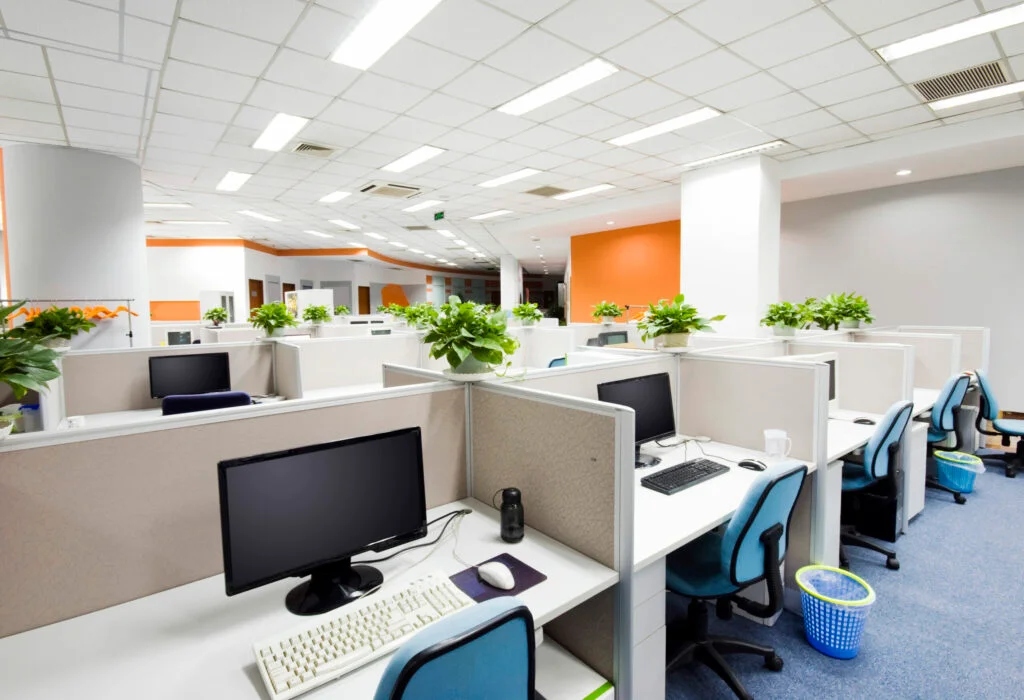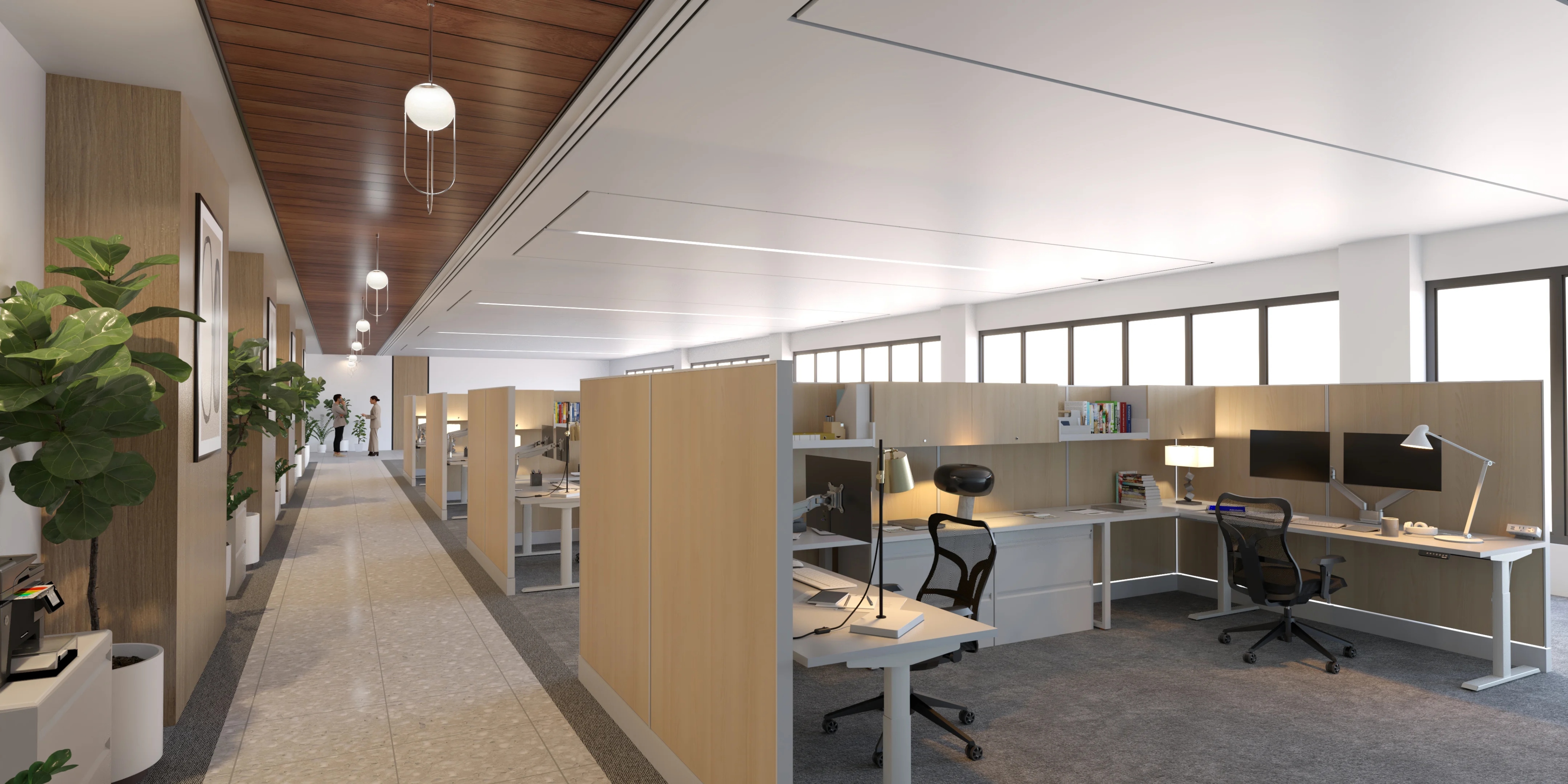How To Absorb Open Office Sound? Creating A Productive And Quiet Workspace
Open floor layouts have become a de facto standard for newer businesses for a variety of reasons. These types of workspaces appear to inspire creativity, facilitate communication, and cultivate a collaborative attitude in the workplace, but noise may be a significant issue in an open office setting. So, how to absorb open office sound?
Author:George EvansJul 31, 2023124.3K Shares1.6M Views

Open floor layouts have become a de facto standard for newer businesses for a variety of reasons. These types of workspaces appear to inspire creativity, facilitate communication, and cultivate a collaborative attitude in the workplace, but noise may be a significant issue in an open office setting. So,how to absorb open office sound?
One of the most prevalent complaints expressed by individuals working in corporate office environments is noise, particularly in open-concept offices where people are crammed into a small space with little to no separation. If you've ever worked in a similar setting, you'll understand how distracting the constant activity of a bustling workplace can be.
That's why, absorbing open office sound is essential to create a comfortable and conducive work environment. So, if you or your employees are bothered by a noisy workplace, it may be time to investigate one or more of the alternatives listed below.
In this article, we will explore various strategies on how to absorb open office sound.
Acoustic Panels And Wall Coverings
In open office layouts, the lack of physical barriers and partitions can lead to excessive noise and sound reverberation, which can significantly impact employee productivity and well-being.
How Acoustic Panels Work?
Acoustic panels are designed to absorb sound waves, preventing them from bouncing off hard surfaces and reducing sound reflections. They are typically made from sound-absorbing materials such as foam, fiberglass, or fabric. When sound waves reach the panels, the porous materials within the panels convert the sound energy into heat, effectively diminishing the noise in the surrounding area.
Sound Absorption And Reduction
One of the primary advantages of using acoustic panels and wall coverings is their ability to absorb sound and reduce noise levels. By strategically placing these panels on walls, ceilings, or partitions, employees can experience a quieter and more focused workspace. The reduction in background noise allows for better communication, concentration, and overall productivity.
Aesthetics And Customization
Acoustic panels are available in a wide range of designs, colors, and shapes, allowing them to blend seamlessly with the office decor. From sleek and minimalist options to vibrant and artistic patterns, these panels can add an aesthetic touch to the office while still serving their functional purpose. They can be customized to fit the office's specific design requirements, creating a cohesive and visually appealing workspace.
Plants And Greenery
In the quest to create a more conducive and productive work environment, integrating plants and greenery into open office spaces offers a natural and effective solution to absorb sound. Open office layouts are notorious for their noise challenges, which can adversely impact employee focus, productivity, and overall well-being.
How Plants Help With Sound Absorption?
Plants are not only aesthetically pleasing but also have inherent sound-absorbing properties. The leaves, stems, and other plant parts are porous and capable of diffusing and absorbing sound waves. When sound encounters the surfaces of plants, a portion of it is absorbed and transformed into heat energy, effectively reducing noise levels and minimizing sound reflections in the open office.
Diffusing Noise And Minimizing Echo
Plants and greenery act as natural diffusers, breaking up sound reflections and scattering sound waves in various directions. This process helps reduce the intensity of noise and minimizes the echo effect, creating a more acoustically comfortable environment for employees.
Biophilic Design Benefits
Incorporating plants and greenery aligns with the principles of biophilic design, which seeks to connect people with nature in the built environment. Biophilic elements have been shown to reduce stress, enhance cognitive function, and promote a sense of well-being. Employees surrounded by nature-inspired elements are likely to experience improved concentration and satisfaction, leading to higher productivity levels.
Zoning And Privacy
Plants and greenery can be used to create designated quiet zones or privacyscreens within the open office. By strategically placing large potted plants or installing green walls, businesses can designate specific areas for focused work, private discussions, or relaxation. These zones offer employees a sense of enclosure and acoustic privacy, supporting various work styles and preferences.
Carpeting And Area Rugs
Another effective way to absorb open office sound is through the use of carpeting and area rugs. Hard surfaces, such as concrete or tile floors, can contribute to sound reverberation, making the office space noisier and less conducive to focused work. Implementing carpeting and area rugs offers several benefits for sound absorption in open offices.
Sound Diffusion And Absorption
Carpeting and area rugs can effectively diffuse and absorb sound waves, minimizing the impact of noise reflections. The fibers in carpeting act as a natural sound absorber, preventing sound from bouncing off the hard floor surfaces and creating a softer acoustic environment.
Improved Acoustic Comfort
The addition of carpeting and area rugs in open offices enhances acoustic comfort, creating a more pleasant and peaceful atmosphere for employees. The reduced noise levels contribute to a less distracting work environment, leading to improved concentration and overall well-being.
Noise Reduction For High-Traffic Areas
High-traffic areas in open offices, such as walkways and common spaces, often experience higher noise levels due to the movement of people and office equipment. By placing carpeting or area rugs in these spaces, the noise generated by footfalls and other activities is dampened, resulting in a quieter and more harmonious work environment.
Aesthetic Value And Design Flexibility
Beyond their acoustic benefits, carpeting and area rugs also offer aesthetic value and design flexibility. They come in various textures, colors, and patterns, allowing businesses to choose options that complement their office decor and brand identity. This integration of design and functionality enhances the overall ambiance of the workspace.
Furniture With Sound-Absorbing Properties
In open office layouts, excessive noise can be a significant challenge that affects employee productivity and well-being. Incorporating furniture with sound-absorbing properties is an effective and innovative solution to address this issue.
By strategically choosing furniture materials and designs that dampen sound, businesses can create a quieter and more conducive work environment. In this section, we will explore the benefits and implementation of furniture with sound-absorbing properties in open offices.
How Furniture With Sound-Absorbing Properties Works?
Furniture with sound-absorbing properties is typically made from materials that have sound-absorbing capabilities, such as felt, acoustic foam, or specially designed fabric. When sound waves reach these materials, they are absorbed rather than being reflected back into the environment, reducing noise levels and creating a quieter atmosphere.
Reducing Noise Reflections
Sound reflections from hard surfaces, such as desks and walls, can exacerbate noise levels in open offices. Furniture with sound-absorbing properties helps minimize these reflections, preventing sound from bouncing around the workspace and reducing overall noise pollution.
Enhancing Speech Privacy
In open office settings, conversations can easily carry across the space, leading to reduced speech privacy. Furniture designed to absorb sound waves can improve speech privacy by dampening the noise created by nearby conversations, creating a more focused and confidential work environment.
Collaborative Spaces And Focus Zones
In open offices, it is essential to create designated collaborative spaces and focus zones to accommodate different work styles. Furniture with sound-absorbing properties can be strategically placed in collaborative areas to enhance communication and reduce noise distractions. Similarly, it can be used in focus zones to promote concentration and uninterrupted work.
Acoustic Solutions For Meeting Rooms
Meeting rooms in open offices are essential for discussions, presentations, and confidential conversations. Furniture with sound-absorbing properties, such as sound-absorbing panels or upholstered chairs, can be integrated into meeting room designs to improve speech clarity and ensure privacy.
Acoustic Partitions And Screens - Best Acoustic Solutions For Open Office Noise
While open office layouts promote collaboration, employees also need privacy and quiet spaces for focused work and confidential discussions. Acoustic partitions and screens offer a flexible and effective solution to create designated quiet zones within the open office. Let's explore the benefits and implementation of acoustic partitions and screens.
How Acoustic Partitions And Screens Work?
Acoustic partitions and screens are designed to absorb and diffuse sound waves, helping to minimize noise propagation in specific areas. They can be made from sound-absorbing materials or constructed with a combination of sound-reflecting and sound-absorbing properties to create desired acoustic effects.
Flexible Office Configurations
Acoustic partitions and screens offer flexibility in office configurations. They can be freestanding or mounted to the ceiling or walls, making them easy to reposition or remove as needed. This adaptability allows businesses to adjust the office layout according to changing needs or work dynamics.
Promoting Collaboration And Communication
While acoustic partitions create quiet zones, they can also facilitate collaboration. By strategically placing them, businesses can create semi-private collaborative spaces where team members can work together without disturbing others nearby.
Reducing Noise Travel
In open office layouts, sound can travel quickly across the space, leading to noise pollution. Acoustic partitions and screens act as barriers, preventing sound waves from traveling long distances and creating a more controlled acoustic environment.
Sound Masking Systems
Sound masking systems offer a dynamic and innovative approach to absorbing open office sound by introducing low-level background noise. These systems emit a gentle and continuous sound, often referred to as "white noise," which serves to mask or cover up other sounds in the environment.
How Sound Masking Systems Work?
Sound masking systems produce a consistent background noise that is designed to be barely perceptible. The sound emitted by these systems blends with the existing office noise, effectively raising the ambient noise level. This, in turn, reduces the detectability and disturbance caused by other noises in the environment.
Reducing Speech Distractions
In open offices, conversations and phone calls can be distracting to nearby coworkers. Sound masking systems help reduce the intelligibility of speech, making it less disruptive to employees who are not directly involved in the conversation. This enhances speech privacy and allows employees to concentrate better on their tasks.
Addressing Variability In Office Noise
Office noise is often dynamic and unpredictable, with fluctuations in volume and intensity. Sound masking systems create a consistent acoustic background that masks the variability in noise levels, promoting a more stable and less distracting soundscape.
Compatibility With Other Sound-Absorbing Solutions
Sound masking systems complement other sound-absorbing solutions, such as acoustic panels and partitions. When used together, these solutions create a comprehensive approach to sound absorption, ensuring a more comfortable and productive open office environment.
People Also Ask
How Can I Reduce Noise In An Open Office Space?
To reduce noise in an open office space, consider using acoustic panels and wall coverings, adding carpeting or area rugs, selecting furniture with sound-absorbing properties, incorporating plants and greenery, and implementing sound masking systems.
What Are The Benefits Of Using Acoustic Panels In Open Offices?
Acoustic panels in open offices help absorb sound waves and reduce noise reflections, creating a quieter and more focused workspace. They can be aesthetically pleasing and are available in various sizes and designs to blend seamlessly with the office decor.
How Do Sound Masking Systems Work In Open Office Environments?
Sound masking systems emit a gentle and constant background noise that helps mask or cover up other sounds in an open office. This creates a more uniform and less distracting acoustic environment, enhancing the overall acoustic experience for employees.
What Types Of Furniture Have Sound-absorbing Properties For Open Offices?
Certain materials, such as felt or acoustic foam, are known for their sound-absorbing properties and can be incorporated into furniture design. Look for sofas, chairs, and workstations with these materials to help reduce noise in an open office space.
How Can Plants And Greenery Help With Noise Reduction In Open Offices?
Plants and greenery in open offices can help diffuse sound waves and reduce the intensity of noise reflections. They contribute to a more pleasant and peaceful atmosphere while enhancing the office's biophilic design.
Conclusion
How to absorb open office sound effectively? Absorbing open office sound is crucial for creating a productive and comfortable workspace. Implementing a combination of strategies such as using acoustic panels, carpeting, furniture with sound-absorbing properties, and plants can significantly reduce noise reflections and create a quieter environment.

George Evans
Author
George Anderson, an exceptional architectural designer, envisions and brings to life structures that transcend the realm of imagination. With an unwavering passion for design and an innate eye for detail, George seamlessly blends form and function, creating immersive spaces that inspire awe.
Driven by a deep appreciation for the interplay of space, light, and materials, George's innovative approach redefines the possibilities of architectural design. His visionary compositions leave an indelible mark, evoking a sense of wonder and transforming the built environment.
George Anderson's transformative designs and unwavering dedication continue to shape the architectural landscape, pushing the boundaries of what is possible and inspiring generations to come.
Latest Articles
Popular Articles


